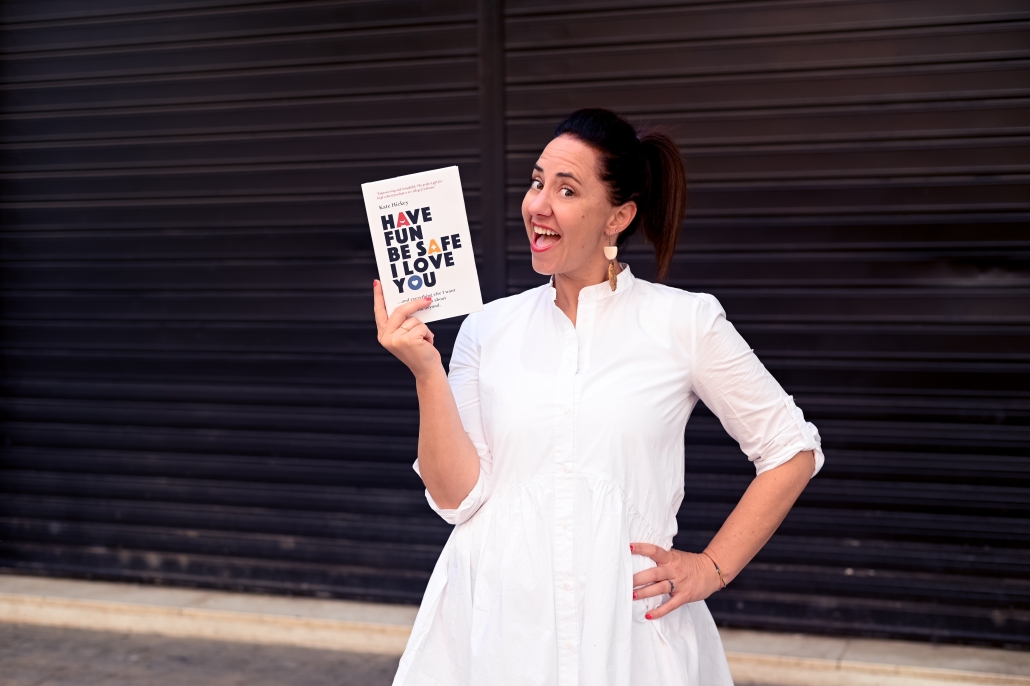Tips for Writing Your First Book + Self Publishing
My book-writing process started on my couch, in a pandemic, with a Google doc. I wrote and edited and wrote some more and then Googled “how to write a book”. One year later – here we are. I did not have an editor, I do not have a doctorate, I am not an “expert” (whatever that means), and I don’t have a publisher. I am a person, on a couch, with a computer just like you.
While I learned a lot about myself throughout this process, here are my practical and tactical tips for writing and self-publishing your first book:
STAY BRAVE
That’s the secret sauce people. Stay brave. Putting yourself out there is scary. Staying committed to the process is hard and telling your story is vulnerable.
But all of our favorite movies, books, songs, and works of art are the direct result of someone’s courage to share their most intimate and honest selves. It’s what defines a page-turner, head-banger, and a tear-jerker. It’s that top-shelf stuff and it requires a splash of self-discovery, a pinch of putting-yourself-out-there, and a loooong and strong pour of bravery.
SELF PUBLISHING VS. USING A PUBLISHER
This is a no-brainer – save yourself time and thousands of dollars and self-publish. Professional publishers can take years, cost a fortune, and then you’re beholden to their rules, timelines, and restrictions. With print-on-demand websites like IngramSpark and KDP from Amazon, you will have full control and still be able to sell your book globally with all the big-box retailers.
Both KDP and IngramSpark have ebook and paperback options but only IngramSpark has a hardcover option which is ultimately why I chose that platform for my book.
GIVE YOURSELF PERMISSION
I battled so much self-doubt and fear on my book-writing journey. I found myself saying “this isn’t new information” or “who am I to be the authority on this topic?” and “who cares about my point of view?”
That was the voice of fear and I’m proud to have pep-talked myself out of that place. The writing process has been so rewarding, humbling, invigorating, and fun. I’m glad I got out of my own way.
If your friend was an aspiring chef, musician. or tattoo designer and said to you:”I’ve been so inspired and wanting to create this amazing piece for so long,” you would say “GO FOR IT!!”.
You are that friend. Go for it. Give yourself permission to create.
Plus haters gonna hate, that’s out of your control.
COSTS
You will likely make little to no money on your book sales. For a hardback book, I make under $3 a copy. If you’re doing this to make money, you’ll have to be a marketing machine.
In fact, the book costs money to publish. ISBN numbers were about $50 (ebook and hardback are 2 different numbers), setting up my book on Ingram Spark was about $100 (including ebook) and I paid my typesetter around $200 and paid a graphic designer for my front cover image.
DON’T TELL PEOPLE YOU’RE WRITING A BOOK
I made a promise to myself that I wouldn’t talk to anyone but my husband about writing my book.
There’s a big difference between “I’m writing a book” and “I’ve written a book”. This was a personal preference for me. I didn’t want to explain my book topic, explain my motives, compromise my confidence, or taint my experience with anyone else’s opinions. This approach allowed me to go into creative mode without having anyone question my intentions, subject matter, or timeline.
While I’m a huge proponent of manifestation and bucket lists, writing a book requires a significant amount of pre-work that I felt needed to be done before I spoke this goal into existence.
USE A TYPESETTER
If you’re self-publishing with IngramSpark or KDP, you’ll have to submit your book online with their complicated templates, which are very limiting in fonts and layout. If you want a well-designed book that looks professional, use a typesetter. I found a fabulous one on Fiverr named Sadie (info linked here) who had years of experience working in publishing. She gave me great tips and saved me countless hours and headaches trying to figure out how to format my book.
To do this part on your own is beyond daunting: bleed lines, spine width, copywriting verbiage, etc. Leave it to the professionals and pay a small fee. It’s worth your time and the book will have a custom, cohesive and professional look. It will also be approved by Ingram Spark in 24 hours without any hassle.
STALK OTHER BOOKS IN YOUR CATEGORY
Take a look at what your competition is doing in the space. I read all of the 1 and 2-star reviews from my competitors which told me what the market wanted. “This book is all about the spiritual journey” or “I wish the author wasn’t so cheesy”. Great. I knew my non-religious and non-cheese book is what people were looking for.
When I was experiencing any self-doubt, I’d go read the crappy reviews from my competitors for a morale boost.
HAVE FUN AND REMEMBER YOUR WHY

You will miss writing when it’s over. I loved waking up to my book early in the morning with my coffee. Enjoy the process, it’s a journey of self-discovery and creation that is unlike anything else.
Remembering why I wanted to write this book made writing a lot more meaningful. This purpose fueled me when I was tired and kept me determined when I hit roadblocks. Have Fun, Be Safe, I Love You is a book to be gifted to graduating high school seniors as a real-talk guide to college and life. As a ten-year teacher, it’s all of the things I wanted to say to them but couldn’t.
When I got discouraged or frustrated, I pictured the book in my daughter’s hands or my former students reading their names on the printed pages. That made it worth it for me.
“My Why” pictured here
FIND A GREAT TEAM
When you feel like you are at least 75% finished writing – have a few trusted people read your work. I am lucky to have a former Journalist for a mom, a published author for a husband, and an English teacher for a sister.
It will be painful to hear feedback but it’s so important. Fresh eyes on my writing helped me realize that some of my tone could have been misinterpreted for offensive, I had about 34,734 errors in punctuation and the organization needed serious attention.
I leaned on a trusted team and without their help, the book wouldn’t be nearly as good. Their perspective was crucial to my confidence in clicking “submit publication”.
It’s tricky, you have to trust yourself and remain open to feedback – it’s a delicate balance. Don’t let your team delay you or shake your confidence but let your book pass through at least 3 trusted sets of eyeballs.
Thank you Mom, Amanda, Karen, Jodie, Trevor, Jason, Matthew, Davita, Eileen, and Paul. You guys showed up for me and I’ll never forget it.
GIVE YOURSELF DEADLINES
I kept editing and tweaking and rewording and at some point, you have to be done.
This is another advantage of having a typesetter. Usually, you have to turn in your edits to a typesetter on a pre-arranged schedule. This will force you to tie a bow on your book.
Give yourself deadlines and be fine with close enough to perfect. If not, you’ll never be finished. Besides, your message is more important than your need to be perfect.
TAKE IT STEP BY STEP
Bird by bird as Anne Lamont famously said. Don’t get overwhelmed with alllll the things. Write first, keep writing, cut 1/3 of the crap, write more, then worry about pricing, covers, ISBN, ebooks, Amazon, and more.
You will figure it all out but not overnight. Try not to worry about the next step until you have to. Everything is on YouTube and Google when you need it. Everything is figureoutable. First, write and enjoy getting it all out of your head.
One thing at a time.
RESEARCH
Listen to writing podcasts, find an online community, and read blogs. All of that time and knowledge pays off. I Googled everything and those virtual rabbit holes usually led to a treasure trove of knowledge.
Understanding how Amazon works, your printer distributes, ebook pricing, etc will help you avoid hours of headache and fixing things when you set them up wrong. Speaking from experience.
STAY ORGANIZED
I would suggest in the beginning just write. Don’t worry about how it’s going to come together – just get it out of your head. As you edit, you’ll start to see your idea come to fruition.
When you decide to cut things, put them in a “Dead Document” because you might want that thinking later. When you find great resources, put those in a “Resources” document. Awesome images for cover “Book Cover” doc. You get it.
Whatever you do – don’t use the printing platform (Ingram Spark) to house your “main copy”. I made this mistake and it had me all sorts of discombobulated.
Being disorganized means you’ll waste hours searching for where you put that quote you liked or that useful article you found.
THE BOOK IS JUST THE BEGINNING
If you want to have a successful and profitable book you will now need to be a marketer/salesperson. This is the part that I have decided is not for me (at least at the moment). Tracking sales, requesting that your book be featured or sold in physical stores, asking for Amazon reviews, climbing to Amazon #1, organizing book signings, doing PR, and getting the book recognized is your next task.
My excitement was the writing and creating. Sales are a bonus.
How can I help you? Email me questions or DM me.
If you are reading this post and you are not interested in writing a book, whatever that other thing was you were thinking about while you read this is exactly what you should do 😉 Stay brave.
Pluck and luck amigos! xo…
Kate



